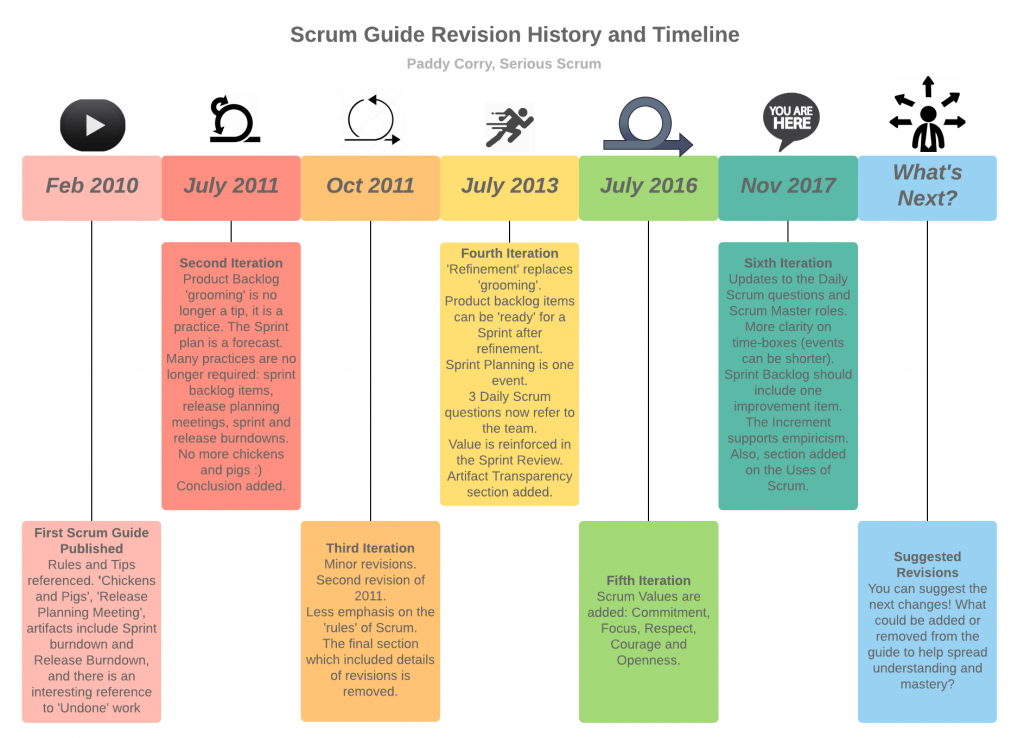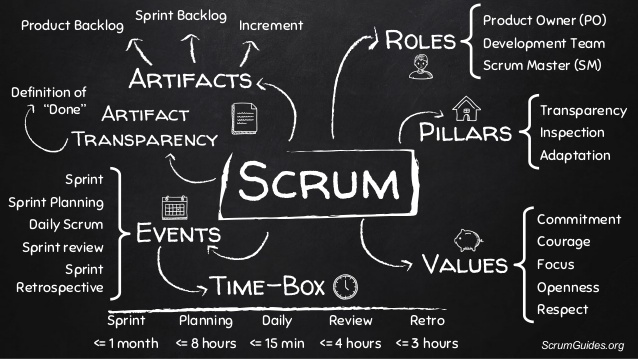Scrum is easy to understand, yet difficult to master. The Scrum Guide says so and it’s true. If you have worked with Scrum in your organization you probably recognize it also. It’s not difficult to start with Scrum. Jasper Alblas wrote a nice article on how to get a head start with Scrum. Read it here: https://www.linkedin.com/pulse/how-get-head-start-scrum-jasper-alblas/
The Scrum Master Checklist
This site is dedicated to Michael James’ Example Scrum Master Checklist, an example list of things a Scrum Master should pay attention to in a typical organization. Check it out at http://scrummasterchecklist.org/
The Evolution of the Scrum Guide— ‘10 to ‘19
The Scrum Guide has changed — are you up to date?

Read the complete article here: https://medium.com/serious-scrum/the-evolution-of-the-scrum-guide-10-to-19-f3ac4d82cfcb
Scrum Guide in One Slide
Moisés Armani Ramírez posted the following image on LinkedIn that captures an overview of Scrum in the following slide:

You can find the original post here: https://www.linkedin.com/pulse/scrum-guide-one-slide-mois%C3%A9s-armani-ram%C3%ADrez/
Fight Zombie Product Ownership with the Product Ownership Evolution Model
Through our studies, we have found that a lack of true product ownership is one of the main causes of Zombie Scrum. This is puzzling as the Product Owner role as such is clearly described in the Scrum framework. However, you would be hard-pressed to find a company that comes even close to living the role the way it was originally intended. Not because these companies successfully set up the Product Owner role as required by the Scrum Guide and then found out that strong product ownership doesn’t help them solve their problems. For numerous, often very understandable reasons they go a quarter of the way and settle on fitting the Product Owner role into their existing organizational structure.
Read the complete article here: https://medium.com/zombie-scrum-resistance/fight-zombie-product-ownership-with-the-product-ownership-evolution-model-1771643c8ba6
My Reading Backlog
I saw some people sharing their reading backlog and thought it was a fun idea to write mine down as well. Looking back at 2018 I was quite surprised how much books I managed to read.
If you know some books I should add to my backlog, please let me know!
A small note: I have not prioritized my todo-list, whenever I finish a book I pick something from it I feel like reading at that moment and start.
Continue reading “My Reading Backlog”Bye Bye Velocity. Hello Throughput.
As published by Louis-Philippe Carignan on Scrum.org
The Professional Scrum with Kanban (PSK) course has now been out for more than 6 months at Scrum.org. As one of the first few trainers who wanted to teach this course when it came out, I find that it is a great way to combine the Scrum framework with Kanban as a strategy to deliver value to your customer.
Out of the many topics that we talk about in this class, I’ve found that the use of throughput instead of velocity/capacity to be a positive change. I’ve taught the regular Professional Scrum Master (PSM) course for about 6 years now and when I get to the Sprint Planning slides, we usually extend the conversation around velocity and capacity. I pull up my complementary slide deck around relative estimation, poker planning, charts to track velocity and we spend an additional hour on this topic. I answer questions around the meaning of story points, how they should be understood, tracked and used in multi-team Agile project.
In the PSK class, this conversation is completely different. When I get to the Sprint Planning slides, I point out that the throughput history is used as an input to the Sprint Planning. With a few examples, I show how easy it can be to get from your electronic Agile tracking system (Ex: Jira) or on your physical Kanban board.
I then get a new set of questions from students which I find a lot more interesting. The conversation goes quickly around the variation in the size of the Product Backlog Items (PBIs) that are taken by the team at Sprint Planning. I can also tie it back to Little’s Law where limiting work in progress will increase throughput, thus helping students see throughput linked to limiting work in progress. There are very few questions around understanding throughput. Students find it is a metric that makes sense to the business compared to story points.
While our industry has talked about poker planning and story points since almost the beginning of agility in 2001, I think it is more than time that the conversation at Sprint Planning shifts to historical throughput instead of using velocity. Maybe one day in the software engineering museum, we can see a deck of poker planning cards next to a set of punch cards.
Differences Between Scrum &Kanban
As posted by Al Shalloway on LinkedIn
Looking at differences between Scrum & Kanban can help us see which will work better for us.
- Scrum requires planning the sprint. You can plan in Kanban but it’s normally isn’t done.
- Scrum requires cross-functional teams. Kanban doesn’t. While making it more flexible if also may miss the opportunity for team structure improvement.
- Scrum requires starting with its roles, practices, events & artifacts. Kanban allows you to start where you are & provides a transition model for improvement.
- Scrum improves by removing impediments. Kanban improves by focusing on shortening cycle time.
Teams that don’t like to be told what to do may resist Scrum. Kanban requires more discipline from the team than Scrum.
Factors to consider when deciding which to use:
- culture– including resistance to being told what to do &attachment to roles
- nature of work being done
- ability to create cross-functional teams
Note that executives can better relate to Kanban’s focus on flow. Combined with its insistence on visibility, executives can better understand the importance of managing workload.
In few cases is one clearly superior to the other. Taking a blend of the two often makes sense. Doing this is not difficult.
Introduction to Scrum
But what is the Scrum methodology, and how does it work? This introduction to Scrum PPT will explore just that. Whether you’re a manager, programmer, tester, product owner, or just want to improve product delivery, check out these Scrum presentations by Certified Scrum Trainer and author Mike Cohn of Mountain Goat Software. Source: https://www.mountaingoatsoftware.com/presentations/an-introduction-to-scrum
I Scrum Agile and is Agile Scrum?
The short version: yes and no! Scrum is Agile but Agile is not (only) Scrum.
Read the complete article here: https://pages.xebia.com/is-scrum-agile-and-is-agile-scrum
